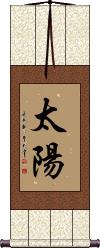Many custom options...
And formats...

Sun Tzu in Chinese / Japanese...
Buy a Sun Tzu calligraphy wall scroll here!
Switched to secondary search mode due to lack of results using primary.
These secondary results may not be very accurate. Try a different but similar meaning word or phrase for better results. Or...
Look up Sun Tzu in my Japanese Kanji & Chinese Character Dictionary(My dictionary is a different system then the calligraphy search you just tried)
If you want a special phrase, word, title, name, or proverb, feel free to contact me, and I will translate your custom calligraphy idea for you.
太陽 is a two-character title for the Sun.
This refers specifically to Sol, the star at the center of our Solar system.
In Japanese, this is often romanized as Taiyou or Taiyo but can also be pronounced as the names Minami, Hiroaki, Hinata, Hikaru, Tsubasa, Tahi, Takayasu, Takaharu, or Soru.
The following table may be helpful for those studying Chinese or Japanese...
| Title | Characters | Romaji (Romanized Japanese) | Various forms of Romanized Chinese | |
| Sun | 太陽 太阳 | tai you / taiyou / tai yo | tài yang / tai4 yang5 / tai yang / taiyang | t`ai yang / taiyang / tai yang |
| In some entries above you will see that characters have different versions above and below a line. In these cases, the characters above the line are Traditional Chinese, while the ones below are Simplified Chinese. | ||||
Successful Chinese Character and Japanese Kanji calligraphy searches within the last few hours...




